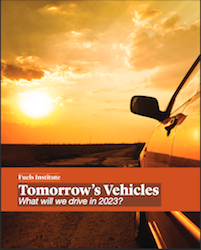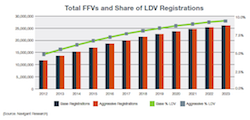According to a new study, “Tomorrow’s Vehicles: What Will We Drive in 2023?” released by the Fuels Institute, the growth of vehicles running on alternative fuels will accelerate over the next decade but diesel-fuel and gasoline-powered vehicles will continue to dominate the market.
 For light-duty vehicles (passenger vehicles and light trucks), gasoline-powered vehicles will continue to dominate the market, although overall market share could decline from 93 percent in 2012 to as low as 82 percent of vehicle inventories in 2023. Diesel-powered vehicles will potentially comprise nearly 7 percent of the market while flexible-fuel vehicles capable of using E85 could grow to more than 9 percent of the market.
For light-duty vehicles (passenger vehicles and light trucks), gasoline-powered vehicles will continue to dominate the market, although overall market share could decline from 93 percent in 2012 to as low as 82 percent of vehicle inventories in 2023. Diesel-powered vehicles will potentially comprise nearly 7 percent of the market while flexible-fuel vehicles capable of using E85 could grow to more than 9 percent of the market.
Meanwhile, for medium- and heavy-duty vehicles (commercial vehicles like trucks and buses), diesel-powered vehicles will prevail, representing at least 94 percent of the vehicle fleet in 2023.
“On the surface, it may not seem that significant change is occurring, because gasoline and diesel fuel-powered vehicles will continue to dominate the vehicle fleet in 2023, but alternatives are gaining traction,” said John Eichberger, executive director of the Fuels Institute. “Consumers appear to be more open to alternatives than ever before and vehicle manufacturers are offering a wider variety.”
Given that there are more than 250 million vehicles on the road today, the report finds it will take years of strong sales of alternative fuel vehicles to reshape the country’s vehicle fleet. In addition, a variety of developments — including cost reductions for alternative-fuel vehicles, conveniently available refueling options, expanded vehicle range and overall consumer familiarity and confidence with new fueling options — will need to occur before alternative-fueled vehicles can capture significant market share.
“We need to ask — and answer — some tough questions so that the vehicles and fueling markets can develop together and convert consumers to new type of vehicles,” said Eichberger.
The report forecast the makeup of the vehicle fleet in 2023 based on two scenarios: a “base case” that incorporates current forecasts and an “aggressive case” that assumes more robust world economic conditions that further spurs demand and prices for petroleum products. In both projections, gasoline-powered vehicles will continue to dominate the LDV market but lose significant market share, dropping from 93.2 percent of LDVs on the road in 2012 to between 82.6 percent to 86.0 percent in 2023. This decline in market share is driven by a shift in the sale of new vehicles, with gasoline-powered vehicles’ share of sales falling from 83.4 percent in 2012 to between 67.6 percent to 78.9 percent in 2023, a potentially dramatic change in consumer purchasing behavior.
 Despite increased attention from policymakers and public-opinion leaders, there are many hurdles to overcome before a robust market emerges for other types of vehicles. But some growth in the next ten years is projected:
Despite increased attention from policymakers and public-opinion leaders, there are many hurdles to overcome before a robust market emerges for other types of vehicles. But some growth in the next ten years is projected:
- Flexible-fuel vehicles: Flexible-fuel vehicles (FFV), which can use both gasoline or E85, show the most promise for growth. In 2012, only 4.7 percent of LDVs were flexible-fuel vehicles; however, automaker production is forecast to double FFV’s share of the market to 9.3 percent of the fleet by 2023. However, the potential for this alternative fuel is tempered by lackluster existing demand and limited availability of E85.
- Natural gas vehicles: The number of light-duty natural gas-powered vehicles (NGV) is expected to see at least a ten-fold increase over the next decade, but will still only represent 0.43 percent in the aggressive case. However, in the M/HDV market, compressed natural gas is projected to capture up to 3.8 percent of the market in the aggressive case. The high cost of installing natural gas facilities at retail and the cost of vehicle conversion or production will be factors limiting additional growth by 2023.
- Propane-vehicles: Propane-powered LDVs are expected to double market share, but will grow from only 0.04 percent to 0.07 percent of all LDVs by 2023. For M/HDVs, propane is currently the second-most-popular option after diesel fuel, capturing 0.38 percent of the market in 2012. However, its growth is considered limited to mainly medium-duty vehicles and will account for no more than 0.76 percent of the M/HDV fleet in 2023.
- Battery-electric vehicles: Unless there are significant breakthroughs in battery-charging technology, battery-electric vehicles (BEVs) will not break out of the niche category of LDVs over the next decade. Even with a projected 22- to 26-fold increase in annual sales over the next decade, BEVs are forecast to be no more than 0.72 percent of the LDV market in 2023.
- Fuel cells: Fuel-cell vehicles (FCVs), electric vehicles that use an external fuel source like hydrogen, are also expected to remain a niche category. Sales are expected to increase significantly over the coming decade, but the reality is that there were only 500 FCVs on the road in 2012. Even in the most aggressive forecast, registrations are only expected to reach 70,000 vehicles — 0.02 percent of the LDV market — in 2023.
“Without coordination between the vehicle and fueling industries, successful market introduction of these systems will be characterized by starts and stops, booms and busts and a protracted — and potentially painful — market development phase that may or may not result in consumer acceptance,” added Eichberger. “Consumers have more vehicle options than ever and where they choose to invest their money will determine the future.”

